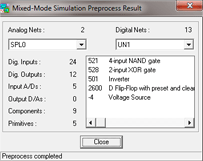Mixed Mode Simulator
 View Video
View Video

Simulation is a design analysis, which replaces design symbols with their
Simulation models and provides a detailed analysis of their behavior. For
Simulating a designed circuit, the model of the real circuit is created taking
all factors into consideration, and the appropriate inputs are given. Then the
outputs at each level are checked and corrections or modifications are made.
Hierarchical simulation has been implemented in EDWinXP Mixed Mode
Simulator.The simulator now supports simulation of hierarchical databases.
In addition to that, two new analysis has been introduced in Mixed mode
simulator that assist end users to design the circuit precisely.
 How to Prepare the circuit for
Simulation?
How to Prepare the circuit for
Simulation?
Monte Carlo analysis is used to calculate component parameter values for a
given output at a given instant of time. Sensitivity analysis points out the
most sensitive component to a particular parameter such as voltage, current,
etc. During simulation all factors are taken into consideration and a model of
the real circuit is created and the inputs are given accordingly. Then the
outputs at each level are checked and corrections or modifications, if any, are
made. There are a number of algorithms used universally to simulate a circuit.
The Mixed-Mode Simulator is one of the best tools used. It can simulate analog,
digital as well as a combination of analog-digital circuits. It is a de facto
that an analog simulator equipped with a logic simulation engine that models the
digital parts of a circuit during the Transient Analysis run. The commonly used
functions by the simulator are: Bias point calculation, Transient
analysis, Parameter sweep analysis, DC Sweep Analysis, AC Sweep Analysis, Monte
Carlo Analysis, Sensitivity Analysis, Preprocessing pass.
 Bias Point Calculation
Bias Point Calculation
 Transient Analysis
Transient Analysis
 Parameter Sweep Analysis
Parameter Sweep Analysis
 AC Sweep Analysis
AC Sweep Analysis
 Monte Carlo Analysis
Monte Carlo Analysis
 Sensitivity Analysis
Sensitivity Analysis